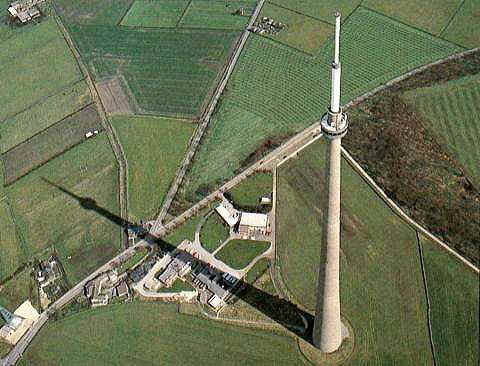 |
UK Broadcast Transmission |
|
|||||||||||
THE TRANSMISSION GALLERY
THE FALL AND RISE OF EMLEY MOOR
| On 19th March 1969 the weight of the ice and the severe winds caused the mast to buckle and collapse resulting in a loss of service to around 5 million viewers. | ||||
|
||||
|
||||
|
The ITA owned an emergency mast, 200ft. high, and by 3 o'clock the following morning it was on its way from their site at Lichfield in Staffordshire. Weather conditions caused some delays but in less than 4 days, ITV signals were restored to 2.5 million viewers. The BBC provided a mobile mast on an outside-broadcast truck and this was used to restore a restricted BBC2 colour service just 40 hours after the collapse. The ITA meanwhile was in the process of obtaining a taller temporary mast from Sweden (once used by the Swedish Air Force) and the parts were shipped to Hull on March 30. A crew of riggers from Poland, who had worked on difficult jobs all over Europe, were brought on board. The 670ft. mast was erected in just under 28 days at a cost of £100,000. However, the mast was only capable of holding one set of aerials, so many viewers in outlying areas still could not see colour programmes. This temporary mast was brought into service at midday on April 16. The BBC later erected a 300ft. mast designed to give better coverage to the area; service was returning to normal. |
|
|||
 |
After the dramatic collapse of the 365m mast local people were unsurprisingly insistent that they did not want another mast on Emley Moor and certainly not one that was so close to where people lived, but this was a prime location... Concerns about safety forced engineers to think hard about the design of the replacement. They came up with the current, stronger, curved concrete tower which, happily, has withstood the test of time. Emley Moor is the tallest self-supporting television mast in Britain standing at a height of 330m (1083ft.). The concrete section reaches to 275m (900ft.) and at this level there is an observation room which is reached by a maintenance lift. The lift journey takes 7 minutes to complete! |
At the top of the tower is a 55m (180 ft.) steel lattice mast which carries the transmitting aerial panels. The tower is not open to the public but trips to the viewing platform have, in the past, been offered as competition prizes. 'Icing was generally believed to have caused the collapse, but a committee of enquiry attributed it to a form of oscillation which occurred at a low but steady wind-speed. Modifications to the similar masts at Belmont and Winter Hill, including the hanging of fifty tons of steel chains within each structure, prevented any recurrence. Assessing where the blame lay took rather longer than replacing the fallen structure. The Authority sued the main contractor, EMI, and the mast designers, BICC. After hearings in the High Court, the Court of Appeal and the House of Lords, a final judgment was delivered on 15-Mar-1980. EMI was found to be in breach of contract and BICC in breach of warranty and negligent. This established liability, but the size of damages remained the subject further litigation. Under an out-of-court settlement reached in the autumn of 1983 the Authority accepted £3.2 million to cover damages, costs and interest.' As a postscript, to bring this story up-to-date, the mast that some local people never wanted became a grade II listed structure on 26-Mar-2003. This is a result of a decision by English Heritage to list post-war communications structures. The BT Tower in London became grade II listed on the same date. |
|
Historic England - Emley Moor | Historic England - BT Tower
|